List of maritime disasters in the 19th century

A maritime disaster is an event which usually involves a ship or ships and can involve military action. Because of the nature of maritime travel, there is often a substantial loss of life. This list covers those disasters where 30 or more lives were lost.
- This transport-related list is incomplete; you can help by expanding it.
Peacetime disasters
Many maritime disasters happen outside the realms of war. All ships, including those of the military, are vulnerable to problems from weather conditions, faulty design or human error. Some of the disasters below occurred in periods of conflict, although their losses were unrelated to any military action. The table listings are in descending order of the magnitude of casualties suffered.
| Year | Country | Description | Deaths | Image | |
|---|---|---|---|---|---|
| 1865 | |
Sultana – On 26 April 1865 this Mississippi riverboat, steaming north with an excessive number of passengers on board, suffered a series of boiler explosions. An estimated 1,800 of her 2,427 passengers died in the ensuing fire or of drowning in the freezing river. | 1,800+ |  | |
| 1822 | Tek Sing – The Chinese ship, called a junk, was bound for Batavia, Dutch East Indies. On 6 February 1822 she tried a shortcut through the Gaspar Strait between Belitung and Bangka Islands and grounded on a reef. The junk sank in about 30 metres (100 ft) of water, killing about 1,600 people.[1] | 1,600 | |||
| 1807 | HMS Blenheim and HMS Java – While sailing in convoy to India both ships were lost without trace in a gale and are presumed to have foundered somewhere off Rodrigues. Blenheim was reported to be in poor shape and it is speculated that Java may have sunk while trying to rescue Blenheim's crew in the storm. About 280 men were lost from Java and 590 from Blenheim. | 870 | |||
| 1857 | Lefort – On 22 September 22, 1857 Lefort was in the Gulf of Finland en route from Reval to Kronstadt along with the ships Imperatritsa Aleksandra, Vladimir and Pamiat Asova. The ship had aboard 756 crew and officers along with 53 women, and 17 children who were families of the crew. The squadron was caught in a sudden squall and Lefort heeled over once, righted herself, then heeled over again and sank between the islands of Gogland and Bolshoy Tyuters with the loss of all 826 people aboard. | 826 | 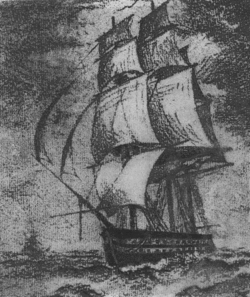 | ||
| 1888 | SS Vaitarna – On 8 November 1888, the ship went missing in the cyclonic storm off the coast of Saurashtra region of Gujarat[2] | 746 | |||
| 1811 | HMS St George – The second-rate was wrecked near Ringkøbing on the west coast of Jutland on 24 December 1811. She narrowly escaped wrecking on a shoal (Rødsand) south of Zeeland on 15 December, while returning from the Baltic Sea. Under jury masts and a temporary rudder she had got a considerable distance out of the Sleeve when a gale came up. This, combined with a heavy sea, resulted in St George being wrecked at Nazen, about three miles from Ringkøbing, together with the HMS Defence. Seven of her 738 crew were saved. Among the dead were Rear-Admiral Robert Carthew Reynolds and Captain Daniel Oliver Guion. | 731 |  | ||
| 1878 | SS Princess Alice – On 3 September 1878 the pleasure steamer was making what was billed as a "Moonlight Trip" to Gravesend and back. Bywell Castle collided with her off Tripcock Point. Princess Alice broke in two and sank within four minutes with an estimated 600 deaths. | 600 | 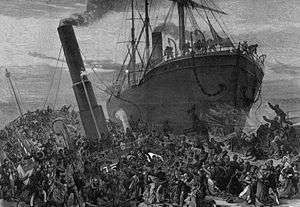 | ||
| 1811 | HMS Defence – on 24 December 1811 the third-rate ran aground off the west coast of Jutland, Denmark. She was under the command of Captain D. Atkins and in the company of HMS St George, under Rear-admiral Robert Carthew Reynolds, and HMS Cressy, when a hurricane and heavy seas came up. St George was jury-rigged and so Atkins refused to leave her without the Admiral's permission. As a result, both were wrecked near Ringkøbing. Cressy did not ask for permission and so avoided wrecking. Defence lost all but 14 of her crew of 597 men and boys, including her captain. St George too lost almost her entire crew, including the admiral. | 583 | 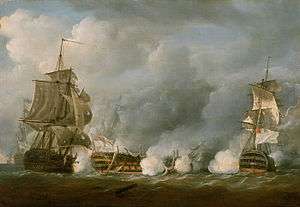 | ||
| 1810 | HMS Minotaur – the third-rate was wrecked off Texel in the Netherlands with heavy loss of life in December 1810. | 570 | 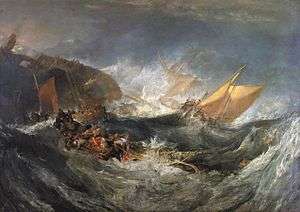 | ||
| 1898 | La Bourgogne – The passenger ship sank on 4 July 1898 after a collision in dense fog with the British ship Cromartyshire off Sable Island, Nova Scotia. La Bourgogne was carrying 730 passengers and crew, of whom 565 were lost.[3] | 565 |  | ||
| 1891 | Utopia – Collided with HMS Anson while trying to enter the Bay of Gibraltar on 17 March 1891. She sank in minutes, killing 562 passengers and crew. Two rescuers from HMS Immortalité also drowned; 318 survivors were rescued. | 564 |  | ||
| 1873 | RMS Atlantic – On the ship's 19th voyage, on 1 April 1873, she ran onto rocks and sank off the coast of Nova Scotia, killing 535 people. | 535 |  | ||
| 1890 | Ertuğrul – Sank on 18 September 1890 after striking a reef in a typhoon off Kushimoto, Japan. 533 sailors died, including Admiral Ali Osman Pasha. | 533 | 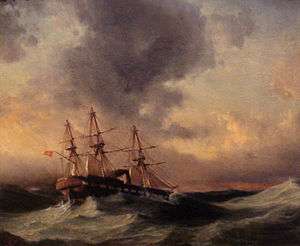 | ||
| 1804 | HMS York – the third-rate left Woolwich under Captain Henry Mitford on the 26 December 1803 for a routine patrol in the North Sea but in January 1804 she struck Bell Rock in the North Sea off Arbroath and sank, killing all 491 men and boys aboard. Captain Mitford was the second son of the historian William Mitford. | 491 | |||
| 1854 | City of Glasgow – a British single-screw passenger steamship that disappeared en route from Liverpool to Philadelphia in January 1854 with 480 passengers and crew aboard. | 480 |  | ||
| 1870 | HMS Captain – On 7 September 1870, the turret ship capsized and sank in high winds on the Atlantic Ocean. An estimated 480 sailors died and 18 survived. | 480 | 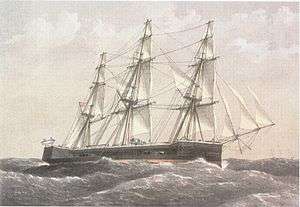 | ||
| 1858 | Austria – On 1 September 1858 the ship caught fire while traveling from Hamburg to New York. The passing barque Maurice rescued most of the survivors and Catarina picked up more the next morning. As the blackened hulk was left to sink all but 65 of 538 passengers were lost. | 473 |  | ||
| 1874 | Cospatrick – The ship caught fire south of the Cape of Good Hope on 17 November 1874 while on a voyage from Gravesend, England, to Auckland, New Zealand. Three of 472 people aboard survived. | 469 |  | ||
| 1859 | Royal Charter – a steam clipper which was wrecked off the beach of Porth Alerth in Dulas Bay on the north-east coast of Anglesey on 26 October 1859 in a storm. The precise number of dead is uncertain as the complete passenger list was lost in the wreck although an incomplete list (not including those who boarded just before departure) is retained in the Victorian Archives Centre in, Victoria, Australia. | 459 | .jpg) | ||
| 1857 | Rival – Carrying volunteers from Glasgow to the Miguelist war, sank off Connemara on 4 December 1832, with the loss of all on board.[4] | 432 | |||
| 1857 | Central America – Sank off the Carolinas on a hurricane on 9 September 1857. An estimated 425 out of 578 aboard died. | 425 | 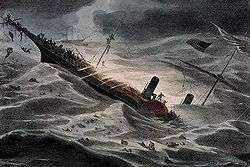 | ||
| 1895 | Reina Regente – the cruiser sank in a storm on 9 March 1895, with the loss of all 420 crew. | 420 | _01.jpg) | ||
| 1845 | Cataraqui – An emigrant ship bound for Australia, she struck a reef south-west of King Island, Tasmania, on 4 August 1845. The sinking is Australia's highest civil maritime civil loss of life, killing 400 people. | 400 |   | ||
| 1860 | Lady Elgin – Sank after a collision with the schooner Augusta of Oswego on Lake Michigan on 8 September 1860 killing about 400 people. | 400 |  | ||
| 1801 | HMS Invincible – On 16 March 1801, the third-rate was damaged in a storm and driven onto a sandbar off the coast of Norfolk. The following day Invincible drifted off the sandbar and sank in deep water. Over 400 crew were lost; 196 saved. | 400 |  | ||
| 1854 | RMS Tayleur – On 21 January 1854 the Charles Moore & Company clipper ship ran aground and sank on her maiden voyage off Lambay Island, Dublin Bay. Of 652 people aboard 380 were lost. Known as the "first Titanic": a White Star Liner, technically advanced for her time, carrying emigrants and lost on her maiden voyage. | 380 | 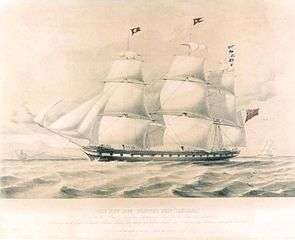 | ||
| 1859 | Pomona – On 24 April 1859 the emigrant ship Pomona (1181 tons) was wrecked on a sandbank off Ballyconigar. She was carrying, mainly Irish, emigrants from Liverpool to New York. Three hundred and eighty nine people lost their lives. The loss of life on the Pomona was the sixth worst in Irish waters surpassed by the Lusitania, Leinster, Norge, Tayleur and Rival[5] | 389 | |||
| 1810 | Elizabeth – On 28 December 1810 she was wrecked in a storm on the outer banks of the Dunkirk brake. At least 380 persons were aboard on leaving Cork, Ireland, and it is thought that the number may have been as high as 400, including at least eight women, all of whom were lost. Among the survivors were six Britons and 15 lascars including two of the ship's crew. | 380–400 | |||
| 1878 | HMS Eurydice – On 24 March 1878,[6] the training ship Eurydice was caught in a heavy snow storm off the Isle of Wight, capsized, and sank. Two of the ship's 378 crew and trainees survived; most of those who were not carried down with the ship died of exposure in the freezing waters. | 376 |  | ||
| 1815 | Arniston – On 30 May 1815, the East India Company ship was wrecked in a storm on the South African coast after a navigational error; 372 people were lost; 6 survived. | 372 | |||
| 1816 | Sea Horse - wrecked in Tramore Bay during storm 30 January 1816. She had been chartered to carry members of the 2nd Battalion of the 59th (2nd Nottinghamshire) Regiment from Ramsgate to Cork. The two other ships carrying the rest of the battalion and members of another regiment were also wrecked nearby, killing a further 12 and 190 people respectively. | 364 | |||
| 1893 | HMS Victoria – Accidentally rammed by HMS Camperdown and sunk on 22 June 1893 in annual summer fleet exercises off Tripoli in Syria (now part of Lebanon) when Vice Admiral George Tryon ordered two parallel lines of ships to turn toward each other. Of Victoria's 715 crew, 357 were rescued and 358 lost, including Tryon. Known as Admiral Tryon's blunder. | 358 |  | ||
| 1875 | Schiller – On 7 May 1875, the ship sank after hitting the Retarrier Ledges in the Isles of Scilly. Most of her crew and passengers were lost, totalling 335 fatalities. | 355 |  | ||
| 1854 | Arctic – a paddle steamer that sank 27 September 1854 off Cape Race, Newfoundland after colliding with the French iron screw steamship Vesta in fog. Of the 534 passengers and crew aboard, 350 were lost, including all 109 women and children. | 350 | .jpg) | ||
| 1853 | Annie Jane – was a passenger ship carrying immigrants that was damaged and sunk in a gale off the coast of Vatersay on 28 September 1853. Of the 450 aboard 348 were lost.[7] | 348 | |||
| 1806 | HMS Athenienne – On the evening of 20 October 1806, she struck a submerged reef on the Esquirques, in the Strait of Sicily and sank. In all, 347 people died, 141 men and two women were rescued. | 347 | |||
| 1895 | Elbe – Sank on 30 January 1895 after a collision with the steamship Crathie in the North Sea. One lifeboat with 20 people in it was recovered out of 354 on the ship. | 334 |  | ||
| 1856 | Cazador – On 30 January 1856 the ship sailed from Talcahuano, Chile bound for Valparaíso carrying the 2nd Company of the Battalion Maipo and their families. The ship ran aground off Point Carranza south of Constitución, Chile: 307–400 people were lost and 23 rescued. | 307–400 |  | ||
| 1887 | Kapunda – On 20 January 1887 the British emigrant ship sank after colliding with the barque Ada Melmoure off the coast of Brazil. Of the 314 aboard 299 were lost. | 299 | |||
| 1873 | Northfleet – On the night of 22 January 1873 she was at anchor about
2–3 nautical miles (3.7–5.6 km; 2.3–3.5 mi) off Dungeness. Around 22:30 hrs she was run down by the steamship Murillo that backed off and disappeared into the darkness. In the ensuing panic a total of 293 people were lost. |
293 | 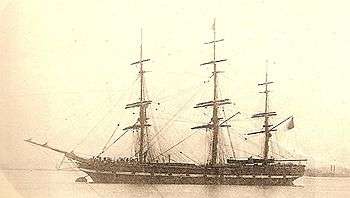 | ||
| 1854 | New Era – On 13 November 1854, the ship sank after grounding in a storm at Deal Beach in New Jersey. Of 427 people aboard, an estimated 284 were lost.[8] | 284 | |||
| 1866 | Evening Star – On 6 October 1866 she sank after sailing into a hurricane 180 miles east of Tybee Island, GA. Of about 300 aboard, 283 were lost. The ship carried lifeboats for 60 people and too few life vests for all aboard. One group of survivors were picked up by a passing vessel and taken to the port of Savannah, GA, while a second group drifted for days and came ashore on the north end of Amelia Island, FL. | 283 | |||
| 1880 | HMS Juno – was a training ship when in 1880 she disappeared with her entire crew after setting sail from Bermuda for Falmouth, England on 31 January 1880. It was presumed that she sank in a powerful storm which crossed her route a couple of weeks after she sailed between 12 and 16 February 1880. | 281 | |||
| 1898 | USS Maine – On 15 February 1898, while at anchor in Havana harbor, Cuba, an explosion of undetermined origin in the ship's magazine damaged and sank the ship. Of the 374 officers and men aboard, 266 died immediately, another eight died later from their injuries. The ship's sinking precipitated the Spanish–American War. | 274 | 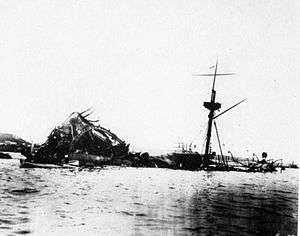 | ||
| 1875 | Pacific – On 4 November 1875 the ship sank as a result of colliding with the steamship Orpheus southwest of Cape Flattery, Washington. Two of the 275 aboard survived. | 273 | .jpg) | ||
| 1878 | SMS Grosser Kurfürst – The ironclad sank on her maiden voyage in a collision with the ironclad SMS König Wilhelm. The two ships, along with SMS Preussen were steaming in the English Channel on 31 May 1878 when they encountered a group of fishing boats and, in turning to avoid them, Grosser Kurfürst inadvertently crossed too closely to König Wilhelm. The latter rammed Grosser Kurfürst which sank in the span of about eight minutes taking between 269 and 276 of her crew with her. | 269–276 |  | ||
| 1805 | Earl of Abergavenny – On 5 February 1805 the East Indiaman Earl of Abergavenny sank shortly after striking Shambles Bank near Portland Bill. Of the 402 people aboard 263 were lost, including her captain John Wordsworth Jr, brother of the poet William Wordsworth. | 263 | 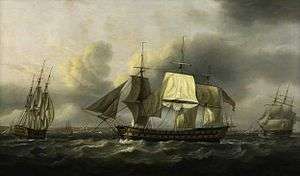 | ||
| 1847 | Cleopatra, with a crew of 151 carrying 100 convicts plus guard from Mumbai to Singapore sank during a tropical cyclone of the Malabar Coast on 14 April 1847.[9] | 251+ | |||
| 1854 | Powhattan – On 16 April 1854, the ship sank off the coast of New Jersey in a severe storm, with no survivors. The loss of life was estimated by various sources to be between 250 and 311 people.[10] | 250–311 | |||
| 1858 | Pennsylvania – On 13 June 1858, the steamboat was on the Mississippi River near Ship Island, below Memphis, Tennessee when her boiler exploded. Her passenger manifest was estimated at 450 and the initial loss of life at 250. The first vessel on site was Imperial, which picked up several passengers and took them to New Orleans. Diana took many others to Memphis. Several were seriously injured and the death toll increased. They included Mark Twain's younger brother Henry Clemens, whose skin and lungs were so badly scalded that he died of his wounds on 21 June. Eyewitnesses testified that the engineer was not at his post in the engine room just prior to the explosion, instead being in the company of some women. | 250 | |||
| 1850 | RMS Royal Adelaide – a paddle steamer that ran between London and Cork. On 30 March 1850 the ship was lost on the Tongue Sands north of Margate with the loss of all aboard. | 250 | |||
| 1847 | HMS Avenger – the frigate sailed from Gibraltar on 17 December 1847 bound for Malta. On 20 December she ran onto the Sorelle Rocks near Malta. Eight of her 250 crew survived. | 242 | |||
| 1850 | G. P. Griffith - On 17 June the paddle steamer G.P. Griffith caught fire and the ship's course altered towards the shore.[11] The Griffith's speed fanned the flames consuming the aft of the ship and forcing the passengers forward. The crew abandoned their posts causing the Griffith's engines to run out of steam and the paddle wheels to slow and stop. However, the ship's momentum carried it forward until it hit a sandbar in water eight feet deep less than half a mile from the beach. Flames quickly consumed the ship, burning to death anyone left aboard. Many passengers jumped into the water, where most drowned or were pulled under by other panicked passengers who could not swim. | 241-289 | 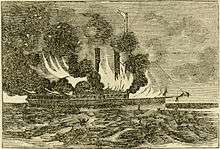 | ||
| 1863 | Anglo Saxon – On 27 April 1863 the steamship ran aground north of Cape Race, killing 237 people. | 237 | |||
| 1873 | Ville du Havre – The liner Ville du Havre collided with Loch Earn in the mid-Atlantic on 22 November 1873. Of 313 passengers and crew, 61 passengers and 26 crew survived. Loch Earn was also abandoned, with all 85 of her passengers and crew being rescued. | 226 |  | ||
| 1865 | Brother Jonathan – was a paddle steamer that struck an uncharted rock near Point St George, off Crescent City, California, on 30 July 1865. The ship was carrying 244 passengers and crew with a large shipment of gold. 19 survived the wreck, making it the deadliest shipwreck up to that time on the US Pacific Coast. | 225 | 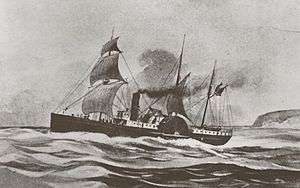 | ||
| 1835 | Neva – She was a convict ship that left Cork, Ireland, bound for Sydney, Australia. On 13 May 1835 she was wrecked on a reef near King Island, Tasmania. 224 people, mainly women and children, were lost. | 224 | |||
| 1866 | London – On 10 January 1866, while travelling from Gravesend in England to Melbourne, Australia, a storm caught and sank the ship in the Bay of Biscay. Of the 239 aboard, 19 were rescued. | 220 | .jpeg) | ||
| 1898 | Portland – On 26 November 1898, the steamship left India Wharf in Boston, Massachusetts, for Portland, Maine, on a regularly scheduled run. She never reached her destination. None of the 192 passengers and crew survived the massive storm that also wreaked havoc on New England's coast – a storm that was later dubbed "The Portland Gale" after the tragic loss of the ship. | 192 |  | ||
| 1870 | City of Boston – a British iron-hulled single-screw passenger steamship of the Inman Line which disappeared in the North Atlantic en route from Halifax, Nova Scotia to Liverpool in January 1870. A fierce gale and snowstorm took place two days after her departure which may have contributed to her loss. Collision with an iceberg was another explanation suggested at the time. | 191 | |||
| 1816 | Boadicea - wrecked in Courtmacsharry Bay during storm 30 January 1816. The ship had been travelling in company with the Sea Horse and Lord Melville which were also both wrecked with heavy loss of life. | 190 | |||
| 1847 | Phoenix On 21 November 1847, the screw steamer Phoenix burned on Lake Michigan with the loss of at least 190 but perhaps as many as 250 lives. | 190-250 | |||
| 1842 | Waterloo – On 28 August 1842 the British convict ship Waterloo was driven ashore, along with several other vessels, when a north-westerly gale struck Table Bay. The ship heeled over on her side and broke apart on the beach, killing 189 of the 302 aboard. | 189 |  | ||
| 1863 | HMS Orpheus – On 7 February 1863 Orpheus sank off the west coast of Auckland, New Zealand after grounding on a sand bar. Of the 259 aboard 189 were lost making it the highest maritime loss of life in New Zealand waters. | 189 | 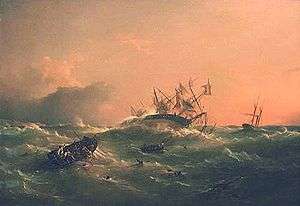 | ||
| 1826 | Nathalie – sank in ice off Newfoundland, British North America in May 1826, killing 189 of the 250 people aboard. She was en route from Granville, Manche to Newfoundland.[12] | 189 | |||
| 1856 | Pacific – a wooden-hulled sidewheel paddle steamer that disappeared with all hands sometime after she left Liverpool on 23 January 1856. Contemporaries concluded she had probably hit an iceberg off Newfoundland, as the ice had been particularly extensive that year. | 186 | .jpg) | ||
| 1881 | Victoria – A double-decked sternwheeler capsized and sank in the Thames River, Ontario on 24 May 1881, 182 people drowned. | 182 | |||
| 1848 | Ocean Monarch – Shortly after leaving Liverpool on 24 August 1848 the barque caught fire and eventually sank outside the harbor. Of 398 people aboard, 178 were lost. | 178 |  | ||
| 1893 | Russalka – On 7 September 1893 the ironclad monitor Russalka sank in the Gulf of Finland in a storm while steaming from Reval to Helsingfors. All 177 of her crew were lost. | 177 |  | ||
| 1814 | USS Wasp - The sloop of war USS Wasp disappeared in October 1814 while headeing for the Caribbean. | 173 |  | ||
| 1833 | Lady of the Lake – was an Aberdeen-built brig that sank off the coast of Newfoundland after striking ice on 11 May 1833 with the loss of up to 265 passengers and crew. | 170–265 | |||
| 1853 | Madagascar – The full rigged ship disappeared without a trace in 1853 after sailing from Melbourne for London, with the loss of about 110 passengers and about 50 crew. | 160 |  | ||
| 1852 | Atlantic – the Collins Line steamship sank after being in collision with the steamship Ogdensburg on Lake Erie off Long Point on 20 August 1852. Of more than 500 people aboard, an estimated 150–200 people were lost.[13][14] | 150-200 | |||
| 1858 | HMS Sappho - It is believed that the HMS Sappho foundered with all hands during February 1858 off the southeast coast of Australia. | 147 |  | ||
| 1854 | HMS Prince – The stores ship was destroyed on 14 November 1854 at a deep water anchorage off Balaklava by a hurricane-force storm which tore her from her anchorage and dashed her onto rocks. She broke up completely within ten minutes; six of her 150 crew were saved. | 144 | .jpg) | ||
| 1881 | HMS Doterel – The sloop sank at anchor off Punta Arenas after an explosion on 26 April 1881 killing 143 members of a crew of 155, while on her way to join the Pacific Station. | 143 |  | ||
| 1894 | Wairarapa (New Zealand) – On 29 October 1894 the steamship, en route from Sydney to Auckland, ran into Great Barrier Island. She was traveling at nearly full speed through heavy fog. About 140 out of 230 people aboard were lost. | 140 |  | ||
| 1840 | Lexington – On 13 January 1840 the paddlewheel steamboat Lexington was en route from Manhattan to Stonington, when a casing around her smokestack caught fire and ignited nearly 150 bales of cotton cargo nearby. The fire could not be extinguished and the ship was abandoned. Her overcrowded lifeboats sank almost immediately after launch, leaving almost all her passengers and crew in freezing water. Of the estimated 143 people aboard, four survived by clinging to floating bales of cotton. | 139 | 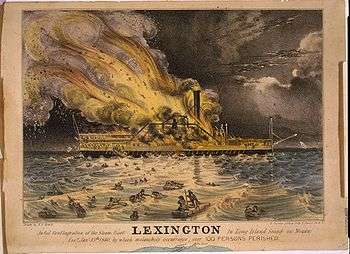 | ||
| 1841 | President – On 11 March 1841 the British passenger liner, with 136 passengers and crew and an extensive cargo manifest, encountered a gale. She was seen on her second day out laboring in heavy seas in a dangerous area between Nantucket Shoals and Georges Bank and was not seen again. | 136 |  | ||
| 1890 | RMS Quetta – was a British-India Steam Navigation Company ship on a regular route between Great Britain, India and the Far East. She was wrecked on the Far North Queensland coast on 28 February 1890. Of 292 people aboard, 134 were lost. | 134 | 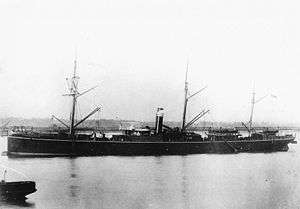 | ||
| 1833 | Amphitrite – The ship sailed from Woolwich, England on 25 August 1833 with 108 women convicts and 12 children. While off Boulogne, France she encountered a gale and was blown ashore on 31 August. The captain refused offers of aid from the shore as prisoners were aboard. The ship then broke up, killing 133 people; three survivors were rescued. | 133 | |||
| 1881 | Tararua – The passenger steamship struck the reef off Waipapa Point in The Catlins on 29 April 1881 in New Zealand's highest civilian shipping loss of life. Of 151 passengers and crew aboard, 20 survived. | 131 | 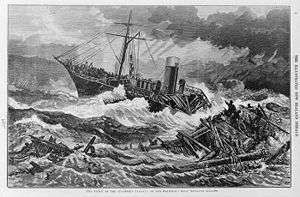 | ||
| 1892 | Bokhara – A steamship that sank in a typhoon on 10 October 1892, off the coast of Formosa, killing 125 people. | 125 | 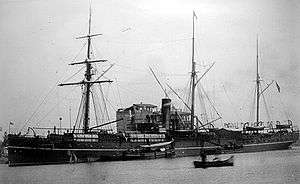 | ||
| 1870 | USS Oneida – The sloop-of-war sank on 24 January 1870 off Yokohama, Japan after the British steamship City of Bombay collided with her and sailed off without giving assistance. Japanese fishing boats saved 61 sailors but 125 men died. | 125 |  | ||
| 1883 | Daphne – capsized and sank moments after her naming and launching at a shipyard in Govan Glasgow, Scotland, on 3 July 1883. When launched, she had a work crew aboard to continue fitting out the ship. Although 70 people were saved, an estimated 124–195 died, which included many young boys. | 124–195 | |||
| 1867 | RMS Rhone – On 29 October 1867 the passenger liner was wrecked off the coast of Salt Island in the British Virgin Islands in a hurricane killing about 123 people. | 123 |  | ||
| 1857 | Dunbar – She was wrecked near the entrance to Sydney Harbour, Australia, in 1857 killing 121 people. | 121 |  | ||
| 1861 | SMS Amazone – On 14 November 1861, off the coast of the Netherlands, the Prussian training vessel sank in a storm, killing 107 of 145 aboard. | 107 |  | ||
| 1898 | Mohegan – The steamship sank off Cornwall after hitting a reef on 14 October 1898, killing 106 people; 40 were rescued by shore-based lifeboat. | 106 | |||
| 1899 | Stella – the British passenger ferry was wrecked on a submerged reef on 30 March 1899, 105 of the 190 passengers and crew aboard were lost. | 105 |  | ||
| 1884 | City of Columbus – the passenger steamship ran aground off Massachusetts in January 1884. About 100 people froze to death or drowned, 29 were saved by rowboats from the shore and a revenue cutter. | 100 |  | ||
| 1875 | Gothenburg – A steamship that was wrecked on the Barrier Reef off the north Queensland coast in 1875, in a cyclone-strength storm, killing between 98 and 112 persons; 22 survived. | 98-112 | .jpg) | ||
| 1850 | Edmond – A chartered passenger sailing vessel that was driven ashore by a storm and broke in two just off the coast of Kilkee, County Clare on 19 November 1850. About 98 people were lost.[15] | 98 | |||
| 1877 | USS Huron – On 23 November 1877 the ship left for a scientific cruise on the coast of Cuba. She soon encountered heavy weather and was wrecked shortly after 0100 hrs on 24 November near Nags Head, North Carolina. For a time her crew worked in relatively little danger, attempting to free their ship but she soon heeled over, carrying 98 officers and men to their deaths. | 98 | |||
| 1847 | Stephen Whitney – On 10 November 1847, while sailing in thick fog, Captain C.W. Popham mistook the Crookhaven lighthouse for the one at the Old Head of Kinsale on the south coast of Ireland. About 10 pm the ship struck the western tip of West Calf Island and completely broke up within ten minutes. Of 110 people aboard, 92 were lost. | 92 | |||
| 1837 | Home – On 7 October 1837 the packet ship struck a sandbar off New Jersey. Unaware of the extent of the damage, her captain continued toward Charleston when she encountered the 1837 Racer's Storm. She started shipping water as she rounded Cape Hatteras and was put aground to ride out the developing storm. Before a rescue could be effected the next day, surf broke her up, killing 90 people. | 90 | |||
| 1881 | Koning der Nederlanden – Her shaft broke on 4 October 1881 and she sank the next day 400 miles of Chagos Archipelago. Three life boats with c. 90 passengers and crew were never found. | 90[16] | .jpg) | ||
| 1859 | Admella – On 6 August 1859 the passenger steamship was wrecked on a submerged reef off Carpenter Rocks, southwest of Mount Gambier, South Australia. Survivors clung to the wreck for over a week and many people took days to die within sight of land and saw successive rescue attempts fail. Of 113 people aboard there were 24 survivors, including only one woman, Bridget Ledwith. Of 89 dead, 14 were children. | 89 | 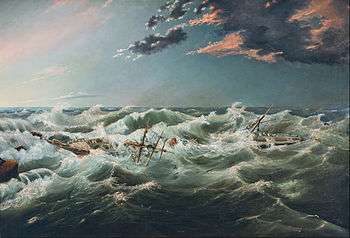 | ||
| 1878 | Metropolis – On 31 January 1878, the wooden steamship sank off the North Carolina coast killing 85 people.[17] | 85 | |||
| 1865 | Comet – On 13 April 1865 fire broke out aboard the clipper ship Comet in the cargo of wool while heading from Moreton Bay, Queensland, Australia for London. The captain and all 80 passengers abandoned ship in 3 boats and were lost. On April 17, just as the Comet was about to sink, the 17 crew members remaining aboard were rescued by the British barque Dauntless. | 81 | 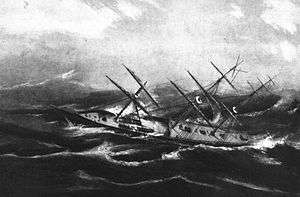 | ||
| 1825 | Kent – On 1 March 1825, in the Bay of Biscay, the Honourable East India Company ship caught fire, exploded and sank. Of those aboard 547 were rescued; 81 were lost. | 81 |  | ||
| 1813 | Currach Fishing Tragedy – On 11 February 1813, 200 currachs were fishing off Bruckless Bay, Donegal. The shoal of herring moved out to sea, followed by the fragile boats. A sudden storm capsized most of them. Over 80 fishermen drowned [18] | 80 | |||
| 1880 | Alpena – The sidewheel paddle steamer capsized and sank on Lake Michigan in the "Big Blow" storm of 15 October 1880. An estimated 80 people were lost. | 80 | |||
| 1892 | Chishima – The Japanese cruiser was lost one week after her formal commissioning into the Japanese navy. On 30 November 1892 the British P&O cargo ship Ravenna struck Chishima amidships cutting her into two off Matsuyama, Ehime in poor weather. Her captain and 74 crew were lost but Ravenna suffered only minor damage. | 75 |  | ||
| 1893 | Naronic – The ship was lost at sea after leaving Liverpool on 11 February 1893 bound for New York, with the loss of all 74 people aboard. The ship's fate remains a mystery. | 74 | |||
| 1882 | HNLMS Adder – Sunk on 5 July 1882 | 65[19] |  | ||
| 1807 | HMS Anson – The third-rate was wrecked off Loe Bar, Cornwall, on 29 December 1807. The previous day she had been driven onto a lee shore by a gale while attempting to return to Falmouth. She had anchored, but the first anchor rope snapped at 4 am. The ships smaller anchor rope broke at 7 am and now with no anchor the Captain attempted to breach the ship but she hit the rocks broadside. The mainmast broke and fell onto the beach and some men managed to get ashore.[20] Estimates of the number of people lost vary from 60[21] to 190.[20] | 60-190 |  | ||
| 1895 | Catterthun – On 7 August 1895, after leaving Sydney bound for Hong Kong the ship ran in to a gale just after midnight near Point Stephens Light. A few hours later, near Seal Rocks, she hit a reef, was badly damaged and sank within 20 minutes. 55 people were lost; one lifeboat with 26 survivors reached shore with the aid of a local sailing boat. | 55 | |||
| 1844 | Lucy Walker – On 23 October 1844, the sidewheel steamboat Lucy Walker was en route from Louisville, Kentucky to New Orleans when her three boilers exploded, she caught fire and sank mid-stream in the Ohio River about 4 miles (6.4 km) below New Albany, Indiana. Débris and body parts were washed up on both banks of the river. Since passenger and crew lists were lost, estimates range from 50 to 100 people lost, with some 50 survivors. The boat may have been racing another vessel, her captain driving Lucy Walker's engines too hard. | 50–100 |  | ||
| 1820 | USS Lynx - The USS Lynx departed St. Mary's, Georgia, on 11 January 1820, bound for Kingston, Jamaica, to continue her service suppressing pirates. She was never seen nor heard from again, and despite the searching of schooner Nonsuch, no trace of her or her 47-man crew was ever found. | 47 |  | ||
| 1876 | HMS Thunderer – On 14 July 1876, shortly after completion, the ironclad turret ship suffered a disastrous boiler explosion which killed 45 people. One of her eight 30 lbf/in2 (210 kPa) box boilers burst as she proceeded from Portsmouth Harbour to Stokes Bay to carry out a full power trial. | 45 | .jpg) |
Wartime disasters
Disasters with high losses of life can occur in times of armed conflict. Shown below are some of the known events with major losses.
| Year | Country | Description | Lives lost | Image |
|---|---|---|---|---|
| 1801 | Second Battle of Algeciras – On the moonless night of 12 July 1801, the large Spanish warships Real Carlos and San Hermengildo fired on one another, each mistaking her consort for a British opponent. Fires that broke out aboard both ships subsequently reached their powder magazines and exploded, destroying the ships and killing the majority of their combined complement of over 2,000 sailors. | 1,700+ | ||
| 1805 | Indomptable – Sank in a storm on 22 October 1805 in the Battle of Trafalgar. Of 1,200 aboard, 1,050 were lost. | 1,050 |  | |
| 1855 | Sémillante – On 15 February 1855 the French frigate was carrying French troops in the Crimean War when she was caught in a storm in the Strait of Bonifacio near the Lavezzi Islands. Lost in a thick fog, a gust of wind drove her into rocks on Lavezzo, and about midnight she sank. Her complement was 301 and she was carrying 392 troops. No-one survived. | 693 | ||
| 1805 | Achille – at the Battle of Trafalgar the Téméraire-class ship of the line caught fire, exploded and sank, killing 480 of her 638 crew. | 480 | ||
| 1805 | Redoutable – After being captured at the Battle of Trafalgar, Redoutable sank in a storm on 22 October 1805. Of 643 aboard, 474 were lost in the battle and sinking. | 474 |  | |
| 1852 | HMS Birkenhead – The troopship struck a rock near Cape Town on 26 February 1852 while ferrying troops to the 8th Xhosa War. The ship sank with the loss of 450 men. | 450 | 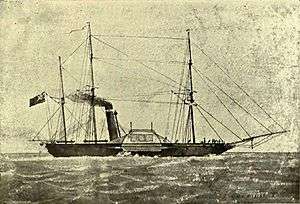 | |
| 1807 | The troopships Rochdale and Prince of Wales – Bound for the Napoleonic war were caught by a storm in Dublin Bay and lost on 19 November 1807. More than 400 people were lost. | 400 | ||
| 1866 | Re d'Italia – The Italian ironclad frigate was rammed and sunk by the Austro-Hungarian flagship SMS Erzherzog Ferdinand Max in the Battle of Lissa on 20 July 1866. After being rammed, the ironclad quickly capsized and sank with the loss of 27 officers and 364 men out of a crew of 558. Other sources reported 440 dead and 160 survivors, or 177 survivors. | 391 |  | |
| 1805 | Aeneas – On 23 October 1805 the British troopship was wrecked after striking a reef on the Newfoundland coast in a storm. Seven of the 347 aboard survived. | 340 | ||
| 1894 | Jingyuan – In the Battle of the Yalu River on 17 September 1894 a Japanese squadron led by Admiral Tsuboi Kozo, with the ships Yoshino, Takachiho, Akitsushima and Naniwa, concentrated fire on Jingyuan for more than an hour. Briefly, Jingyuan seemed to be closing on Yoshino in an attempt to ram but at 16:48 she lurched to starboard and burst into flames. Soon after, with a large explosion, Jingyuan rolled over and sank. Of 270 crew, seven survived. | 263 | .jpg) | |
| 1807 | HMS Ajax – In the Dardanelles Operation a fire destroyed the third-rate. It broke out on 14 February 1807 in the bread-room, where the Purser and his assistant had negligently left a light burning, while Ajax was anchored off Tenedos. As the fire burned out of control the officers and crew were forced to take to the water. 250 men were lost; 380 were rescued. | 250 | .jpg) | |
| 1894 | Zhiyuan – In the Battle of the Yalu River on 17 September 1894 Zhiyuan was hit in the bow by a shell fired by either Naniwa or Takachiho at 15:50 hours which caused a great explosion after which she rapidly sank. Of her 252 officers and men, 245 were lost. | 245 |  | |
| 1866 | Palestro – The Italian ironclad screw gunboat was set afire and later exploded in the Battle of Lissa, on 20 July 1866. The explosion killed 19 officers and 193 men; 23 survived. Other sources report 231 dead and 19 survivors, or 228 dead and 26 survivors, or 227 casualties out of a crew of 269. | 212-231 | ||
| 1895 | Laiyuan – In the Battle of Weihaiwei on 5 February 1895 the Chinese cruiser was attacked by two Japanese torpedo boats and struck by a torpedo fired by Kotaka. Laiyuan rolled over and capsized with a loss of about 170 of her crew of 270. | 170 | ||
| 1807 | HMS Primrose – In January 1809 the brig-sloop sailed for Spain as part of a convoy. In a snowstorm she ran aground at 5am on 22 January on Mistrel Rock, The Manacles, a mile offshore, and was wrecked. The sole survivor was a drummer boy. | 120 | ||
| 1809 | HMS Lark – On 3 August 1809 the sloop foundered in a gale off Cape Causada (Point Palenqua), Santo Domingo. She was at anchor when the gale struck and had set sail at daybreak to get out to sea. While she was shortening sail a squall struck that turned her on her side. A heavy sea struck her and she filled rapidly with water. She sank within 15 minutes, killing most of her crew. Some survived by clinging to floating wreckage. However, by evening when the brig-sloop HMS Moselle arrived all but three of her 120 crew were dead. | 117 | ||
| 1864 | USS Tecumseh – The Canonicus-class monitor was sunk by a mine on 5 August 1864 in the Battle of Mobile Bay. She capsized and rests upside down northwest of Fort Morgan. Of 100 aboard, 94 were lost. | 94 | .jpg) |
See also
- List of maritime disasters
- List of maritime disasters in the 18th century
- List of maritime disasters in the 20th century
- List of maritime disasters in World War I
- List of maritime disasters in World War II
- List of maritime disasters in the 21st century
- Shipwreck
- List of shipwrecks
- List of disasters
- List of accidents and disasters by death toll
- List by death toll of ships sunk by submarines
- List of RORO vessel accidents
References
- ↑ "The Legacy of the Tek Sing c.1822". South East Asia Antiques. S.E.A. Antique. 2002. Retrieved 30 June 2013.
- ↑ Vashi, Ashish (6 May 2010). "Gujarat saw a Titanic in 1888". The Times of India. Retrieved 3 June 2015.
- ↑ "La Bourgogne". Shipwrecks of Nova Scotia. nswrecks.net. Retrieved 9 December 2008.
- ↑ Bourke, Edward. "The loss of the Rival In Connemara". http://lugnad.ie/. On-line Journal of Research on Irish Maritime History. Retrieved 26 March 2015. External link in
|website=(help) - ↑ Bourke, Edward. "Pomona, emigrant ship, 389 died". On-line Journal of Research on Irish Maritime History. Retrieved 15 March 2015.
- ↑ West, Jenny (1973). The Windmills of Kent. London: Charles Skilton Ltd. p. 51. ISBN 0-7050-0065-6.
- ↑ "Annie Jane [+1853]". Wreck Site. Retrieved 28 September 2013.
- ↑ "Appalling Shipwreck of the New Era". The Monthly Nautical Magazine, and Quarterly Review. April–September 1855. pp. 223–224. Retrieved 8 December 2008.
- ↑ Charles Rathbone Low. History of the Indian Navy. p. 194.
- ↑ "The Powhatan Tragedy". Retrieved 8 December 2008.
- ↑ Rowe, Daniel (2009). Lake Tales. Lulu.com. pp. 96–99. ISBN 978-0-557-08885-0. Retrieved 31 May 2015.
- ↑ "Ship News". The Herald (2476). 15 September 1826.
- ↑ "Vessel Profile". Shipwreck Central. Retrieved 22 November 2008.
- ↑ Egidius, Nanna; Austheim, Trond; Solem, Børge (April 2001). "Disaster on Lake Erie in 1852". Great Disasters Main Page. Norway-Heritage (hands across the sea). Retrieved 22 November 2008.
- ↑ "The Wreck of the 'Edmond' at Kilkee, 1850". Clare Library. Retrieved 10 February 2013.
- ↑ "SS Koning der Nederlanden". wrecksite.eu. 2001. Retrieved 2014-04-21.
- ↑ Means, Dennis R (1987). "A Heavy Sea Running: The Formation of the U.S. Life-Saving Service, 1846–1878". United States Lifesaving Service. Retrieved 8 December 2008.
- ↑ Bourke, Edward. Shipwrecks of the Irish Coast. 1. p. 213. ISBN 0-9523027-0-5.
- ↑ "Adder". wrecksite.eu. 2001. Retrieved 2014-04-21.
- 1 2 Treglown, Tony (2011). Porthleven in years gone by Local Shipwrecks. Ashton: Tony Treglown.
- ↑ Gilly. Narratives of Shipwrecks of the Royal Navy. p. 125.